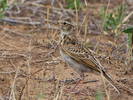search
classification
|
basic information
|
Sky Lark
Alauda arvensis (Linnaeus, 1758)

|
 adult
|
|
|
2021-06-07
Altai region |
© Nadezhda Orlova
|
|
Description
Adult males and females of the Skylark have typical "Lark" coloring. This type of color is formed by the combination of the brown or brownish shafts and centers of feathers with the buffy or grayish-buffy edges of feathers. The crown is with narrow dark streaks; the ear coverts are brownish. The supercilium is pale. The mantle and upperwings are with broad dark streaks. The flight feathers are with pale edges; the outer web of the second primary is off-white; the underwing coverts are pale, grayish-brownish. The tail feather excepting two outer pairs are blackish-brown, outer pair is white with the dark spot in the base part of inner web; the second pair is with white outer web. The third pair have only off-white edge on the outer web. The spread tail looks black with white sides. The throat, breast and abdomen are off-white, dirty-buff. The chainlets of little spots begin on the bill base and stretch on the throat. The craw-sides have dark mottles; the broader and more washed spots are on the flanks. After the autumn molting in fresh plumage the birds have brighter color; the spots and streaks are darker and neater; the edges are broader with more expressive buffy tinge on the webs borders. The eyes are brown; upper mandible is brownish; low mandible is pale. The legs are brownish-grey; the claw of rear toe is long and not curved. Juveniles in first plumage are mottles above and grayish-buff slightly mottled below. The mottled pattern formed by the off-white tips of the feathers. In first autumn plumage the juveniles are similar on adults but have the brownish centers of feathers of upperparts, and broader buffy edges. Sizes: males – wing 104.5-118, tail 68-83.5; females – wing 97-113.8, tail 62.5-74.6 mm. Weight: 28-48 grams.
Biology
The Skylark is common, in some places abundant, breeding migrant. Inhabits steppe (feather-grass/fescue, fescue/wormwood types), meadows, areas of meadow/steppe intergrades, fallow land, on or near agricultural fields, both on plains and in mountains up to 1700 m in Altai and 2000-2600 m in Tien Shan. During migration occurs on tracks, stubble, pasture and hayfields. In southern areas it arrives late February to early March, when first thaw appears, and from end of March to early April further north, in strong flocks numbering dozens to hundreds of birds. Last migrants recorded late March to late April. Breeds in separate pairs, not very far one from another. Nest is built in shallow scrape under grass shelter and made from dry grass lined with thin grass and sometimes with hair or down. Clutches of 3-6 eggs found in early April – mid June. Only female incubates, for 14 days. Both parents feed juveniles, which fledge at 10 days, from early May to early July. On plains, in foothills and in Altai double brooded, repeated breeding after nest loss (normally due to predation by harriers or snakes) is very common. Skylarks feed juveniles by insects, basically by bugs and locusts. Adults often eat tubers and seeds of plants, gladly peck wheat, millet and oats, but take seeds only from the ground. Birds wander from end of July to August, but autumn migration begins in September. Most birds leave in late September to mid October. Mass flights have been observed, especially after snowfall. Last migrants recorded late October – early November, with some lingering to early December. Sometimes wintering in Central Kazakhstan, and many remain in southern areas, particularly during mild winters.
References














